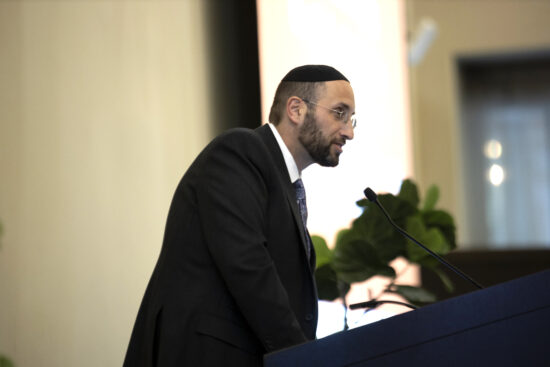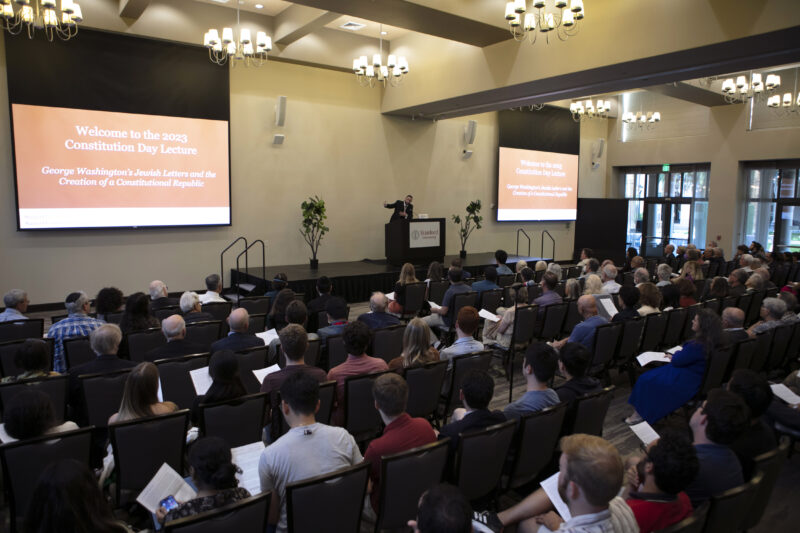Constitution Day 2023: George Washington’s Correspondence with America’s Jews Illuminates a Country Founded on a Covenant
Since 2004, September 17 has been designated as Constitution Day to commemorate the signing of the U.S. Constitution in Philadelphia on September 17, 1787. Rather than fireworks and festivities, the focus of Constitution Day is on education. All academic institutions that receive federal funds, including Stanford University, host events on or near September 17 to encourage people to learn more about the central legal document that has governed the United States for 236 years.
At Stanford Law School (SLS), the Stanford Constitutional Law Center has annually marked the occasion with presentations by high-profile judges, policy makers, scholars, and others. This year’s event, held September 12 at Paul Brest Hall, featured a presentation by Rabbi Meir Soloveichik, the director of the Straus Center for Torah and Western Thought at Yeshiva University and the rabbi of New York City’s Congregation Shearith Israel, the oldest Jewish congregation in the United States. The lively discussion provided approximately 150 attendees with a rare perspective on the country’s founding ideals of religious liberty through the eyes of America’s earliest Jewish citizens. Robert Weisberg, JD ’79, the Edwin E. Huddleson, Jr. Professor of Law and SLS’s incoming interim Dean, provided opening remarks along with Michael McConnell, the Richard and Frances Mallery professor of law, director of the Constitutional Law Center, and a senior fellow at the Hoover Institution.
Soloveichik framed the evening’s discussion around several letters between members of early America’s small Jewish population and George Washington. According to Soloveichik, the flowery, 18th-century missives to and from Washington, who served as President to the Constitutional Convention, reveal that the Founders identified deeply with the story of the Jewish people and viewed the Biblical story of ancient Israel as parallel to that of America. The letters also offer remarkable insight into how the country’s approximately 1,000 Jewish residents embraced the new Constitution and the promises of the nascent nation, Soloveichik explained.
Quoting and paraphrasing Rabbi Jonathan Sacks’ description of the uniqueness of America, Soloveichik said that “As it was for the Israelites, the Founders saw the new country as a covenant society…Covenant societies represent conscious new beginnings; they are founded on an idea, dedicated to a proposition, and united around a text, a series of laws, doctrines, and ideas. So on Constitution Day, we reflect on a nation defined by its dedication to ideas.”
The Founders’ idea of a republic built on a pillar of religious liberty propelled Enlightenment-era ideals of freedom and liberty far beyond the notion of mere religious tolerance, as espoused by philosophers like John Locke, he explained. This defining attribute of the new nation was embedded in Article VI of the Constitution, specifying that “no religious Test shall ever be required as a Qualification to any Office or public Trust under the United States.” The “No Religious Test Clause” banned–at least on the federal level–a form of religious discrimination practiced in England and in the early United States and has provided one of the country’s textual commitments to religious liberty for more than two centuries.
A Letter to Washington from Jonas Phillips
Soloveichik told the story of Jonas Philips, a German Jew who arrived in Charleston, South Carolina in 1756, making his way to New York where he joined what is now Soloveichik’s congregation. (Shearith Israel, founded in 1654, already had been an active congregation for 100 years when Phillips arrived.) Peppering his speech with jokes that had the audience roaring with laughter, Soloveichik explained that the Revolutionary War veteran and successful merchant fathered 21 children and was therefore “quite literally one of America’s founding Jewish Fathers.”

On September 7, 1787, Phillps sent a letter to Washington asserting that despite the general level of acceptance for Jews in the new United States, and the fact that many had fought as patriots in the Revolution, they still were not truly free because an oath affirming the truth of the Old and New Testaments was a requirement to serve in the statehouse. Phillips did not know that the draft of the Constitution already included the “no religious test” clause, but his letter sheds light on the ideals that America’s Jews hoped the new country would live up to, ideals that had never been seen “anywhere else on Earth in diaspora history,” Soloveichik said.
“My ancestors living at the time in Poland and Lithuania would have given a lot to live the life Jonas Phillips was living,” Soloveichik said. “Here is someone who was a friend of American Founding Fathers, he is wealthy and accepted in general society. He just couldn’t serve in the legislature if he wanted to preserve his fealty to Judaism. So what Phillips is audaciously arguing to the most famous man in America is that if Jews were not equally able to serve society in all respects without violating their faith and conscience, then America was not living up to the promise for which he fought.”
This promise, Soloveichik continued, was both distinctly American and distinctly Jewish: a person can be both “a neighbor and a stranger,” being fully and completely part of general society while remaining dedicated, both in private and public life, to their minority faith.
America’s Jews Celebrate the New Constitution
Soloveichik recounted a parade in Philadelphia in 1788 that marked Pennsylvania’s ratification of the new Constitution. Founding Father Benjamin Rush’s description of the summer day highlighted the Jews’ ability to be wholeheartedly engaged in civic affairs, according to Soloveichik, who paraphrased Rush’s account:
“He saw ‘the clergy of the different Christian denominations with the Rabbi of the Jews walking arm in arm.’ Rush reflected that this was ‘a most delightful sight, there could not have been a more happy emblem contrived, of that section of the new Constitution which opens all its power and offices alike, not only to every sect of Christians but to worthy men of every religion.’”
Another account of the day came from Jonas Phillips’ son who recalled a special table of kosher food set out for the Jewish parade-goers, complete with “soused salmon, which is lox, because obviously you can’t have a Jewish event without lox,” said Soloveichik to more laughter. “This is quite possibly the first time that a separate kosher table has been provided by a government at a civic celebration anywhere on Earth and it is impossible to imagine such a phenomenon occurring in France or England in the 19th century, let alone in 1788. When Philadelphia celebrated the Constitution, Jews were fully welcomed as part of the civic and social fabric.”
Washington’s Letters to the Jews
When Washington became president, he received one letter of congratulations from the Catholics, one from the Quakers, one from the Baptists and so on, Soloveichik said. “The Jews in America could not agree who would write the letter, and so they sent him three letters. There’s maybe 1,000 Jews in the United States. Three letters,” Soloveichik said with a laugh. Washington answered each one.

Washington expressed the essence of the Constitution in his response to the Jews of Newport, Rhode Island, writing, “It is now no more that toleration is spoken of as if it was by the indulgence of one class of people that another enjoy the exercise of their inherent natural rights.” To the Jews of Savannah, Georgia, he wrote, “May the same wonder-working deity who long since delivering the Hebrews from their Egyptian oppressors planted them in the Promised Land, whose providential agency has lately been conspicuous in establishing these United States as an independent nation, still continue to water them with the dews of Heaven and to make the inhabitants of every denomination participate in the temporal and spiritual blessings of that people whose God is Jehovah.”
Soloveichik closed his presentation by recounting how on Memorial Day, his synagogue visits its cemetery to plant flags on the graves of congregation members who fought in the American Revolution, including Jonas Phillips. The tradition allows him to annually reflect on Jewish people’s unique role in the United States, having fought for and achieved the freedom to be citizens without sacrificing their Jewishness, public or private, in any way.
About Rabbi Meir Soloveichik
Meir Soloveichik is the Director of the Straus Center for Torah and Western Thought at Yeshiva University, and the Rabbi of Congregation Shearith Israel, the Spanish and Portuguese Synagogue in Manhattan, the oldest Jewish congregation in the United States. His recent book, Providence and Power: Ten Portraits in Jewish Statesmanship, was published in May 2023. In 2018, he was the recipient of the Becket Fund’s Canterbury Medal for his efforts on behalf of religious liberty.
About the Stanford Constitutional Law Center
The Stanford Constitutional Law Center focuses particularly on the separation and scope of legislative, executive, and judicial powers; the structure of constitutional democracy; the freedoms of speech, press, and religion; and the right of privacy, including the privacy of personal data in a digital world. Founded in 2006 by former Dean Kathleen Sullivan, the Constitutional Law Center is currently led by Faculty Director Michael W. McConnell, Richard and Frances Mallery Professor of Law.
About Stanford Law School
Stanford Law School is one of the nation’s leading institutions for legal scholarship and education. Its alumni are among the most influential decision makers in law, politics, business, and high technology. Faculty members argue before the Supreme Court, testify before Congress, produce outstanding legal scholarship and empirical analysis, and contribute regularly to the nation’s press as legal and policy experts. Stanford Law School has established a model for legal education that provides rigorous interdisciplinary training, hands-on experience, global perspective and focus on public service, spearheading a movement for change.

